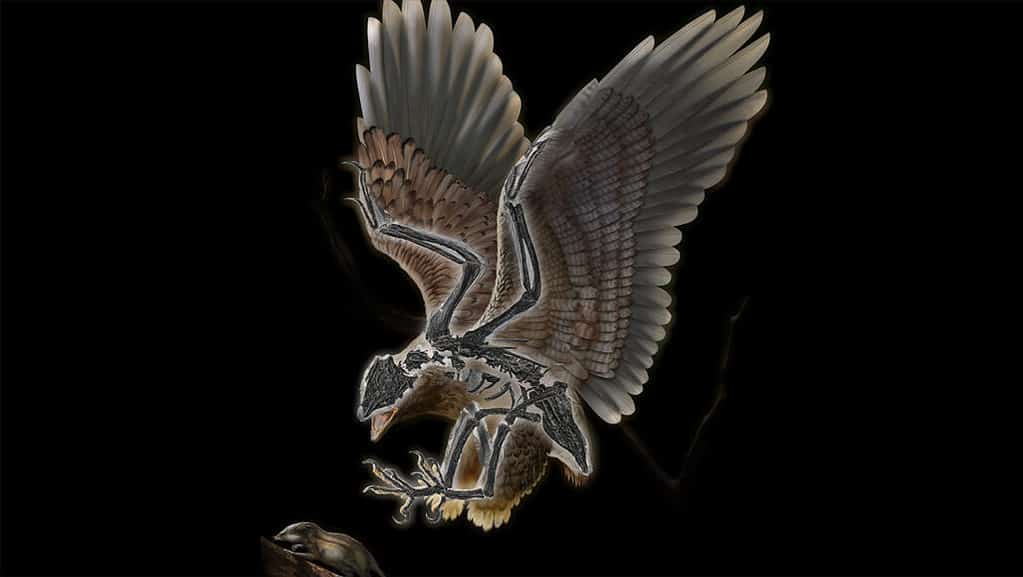
Around 65 million years ago, a devastating asteroid impact off the coast of the Yucatán Peninsula in Mexico unleashed an armageddon that famously wiped out the vast majority of dinosaurs — but not all of them. The only dinosaurs that survived the dreaded planetary winter that followed the asteroid impact were birds, which originally evolved from a group of meat-eating, two-legged dinosaurs called theropods, whose members include the towering and menacing Tyrannosaurus rex.
But although birds have survived to this very day and represent one of the most successful groups of vertebrates, we still know very little about this remarkable transition from therapods to the lightweight, feathered, and winged body plan we all recognize today. But the discovery of a very bizarre 120-million-year-old fossilized bird from China is helping scientists get a better understanding of the origin of birds, even though it’s a winding path where they often have to make one step forward, but two steps back.
A dinosaur’s head on a bird’s body
The newly dove-sized identified specimen, known as Cratonavis zhui, is unique among birds. It has a conventional dinosaur-like skull, which is articulated with a bird-like body. In fact, the high-resolution computed tomography (CT) scans of fossils suggest that the Cratonavis skull is morphologically nearly identical to that of dinosaurs such as Tyrannosaurus rex rather than being bird-like. In addition, preserves a surprisingly elongated scapula and first metatarsal (foot bone), features that are altogether absent from modern birds.
“The discovery of Cratonavis zhui sheds new light on the complex and fascinating evolution of birds. This new information helps us to better understand the ancestral roots of birds, including parrots, and how they have evolved over millions of years to become the diverse and colorful creatures we know and love today,” said ornithologist Carrie Stephens of All About Parrots.
The team of paleontologists from the Chinese Academy of Sciences used the CT scans of the mineralized bones to reconstruct the shape and function of Cratonavis‘s skull, revealing how this peculiar primitive bird moved and behaved during the Cretaceous. The flattened specimen was unearthed from the Jiufotang Formation, an ancient body of rock in northeastern China where many other feathered dinosaurs and archaic birds had previously been discovered.
“The primitive cranial features speak to the fact that most Cretaceous birds such as Cratonavis could not move their upper bill independently with respect to the braincase and lower jaw, a functional innovation widely distributed among living birds that contribute to their enormous ecological diversity,” said Dr. LI Zhiheng from the Chinese Academy of Sciences, a lead author of the study.

Cratonavis‘s mixed bunch of therapod and bird-like features places it somewhere between the more reptile-like long-tailed Archaeopteryx and the Ornithothoraces (a more advanced group of birds from the age of dinosaurs) in the evolutionary tree. As for the surprisingly long scapula and first metatarsal, the researchers believe that during the long transition from therapod to full-fledged bird, the first metatarsal became gradually shorter due to natural selection until it reached its optimal size, less than a quarter of the length of the second metatarsal.
During its heyday, Cratonavis might have used this mighty long digit to hunt like today’s birds of prey. However, given its small stature, Cratonavis likely couldn’t take down prey larger than beetles or grasshoppers.
“The scapula is functionally vital to avian flight, and it conveys stability and flexibility. We trace changes in the scapula across the Theropod-Bird transition and posit that the elongated scapula could augment the mechanical advantage of muscle for humerus retraction/rotation, which compensates for the overall underdeveloped flight apparatus in this early bird, and these differences represent morphological experimentation in volant behavior early in bird diversification,” said Dr. Wang Min, the corresponding author of the new study.
But intriguing as Cratonavis may be, the dino-bird mishmash is not entirely unexpected. There’s an increasing body of evidence that suggests that the transition from therapod to modern birds wasn’t clear-cut nor smooth but rather went through numerous iterations and evolutionary experiments that resulted in a range of primitive birds with mosaical features.
The findings appeared in the journal Nature Ecology & Evolution.


